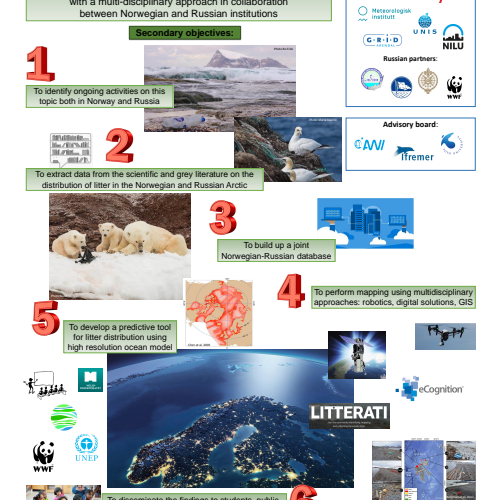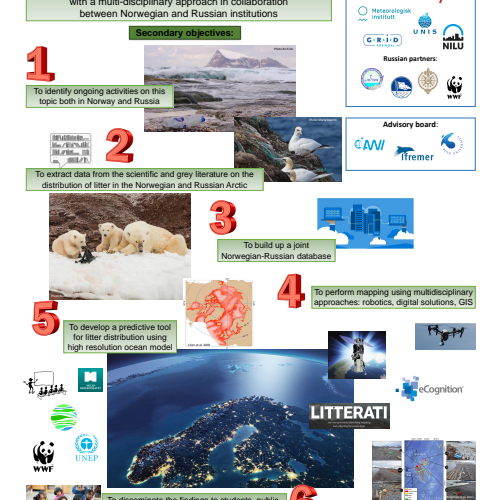7 November 2018 news
This week Lionel Camus and Alexei Bambulyak from Akvaplan-niva are visiting Moscow to present the MALINOR program on marine litter in the Norwegian and Russian Arctic Seas financed by the Research Council of Norway NORRUSS program. The event was the Norwegian-Russian seminar on Prevention of Marine Plastic Litter and Microplastics in the Barents Sea that was held November 7 - 8, hosted by the Ministry of Nature Resources and Environment of Russia. At the event Alexei Bambulyak was commissioned to act as rapporteur for 'the Joint Norwegian-Russian Commission on cooperation in the field of environment' and Lionel Camus coordinated the discussion panel.
The Research Council of Norway program NORRUSS is a social science research programme on The High North/Arctic and Russia. In the last call for projects, with a budget of 50 million NOK, the program received 38 applications to the total sum om 137 Million NOK. 13 projects received funding in the tough competition and one of these was the MALINOR project led by Akvaplan-niva Tromsø. The project leader is Senior Scientist Lionel Camus, Akvaplan-niva. Other Norwegian partners in the project are UiT The Arctic University of Norway, UNIS, the Norwegian Institute for Air Research (NILU), Maritime Robotics, the Norwegian Meteorological Institute, GRID Arendal and SALT. Russian partners are Murmansk Marine Biological Institute, Zubov State Oceanographic Institute of Roshydromet, WWF Russia and Association Maritime Heritage.
Mapping marine litter in the Norwegian and Russian Arctic Seas (MALINOR)
While plastic appeared to be a great invention as described by the french philosopher Roland Barthes in Mythologies (1957) who used the term "a plasticized world" for the benefit of all, today the enthusiasm for plastic would certainly not be the same anymore. 8.3 billion tons of plastic have been produced between 1950 to 2015 of which some ends up in the sea generating the so-called "marine litter" which does poorly degrade, accumulate on the sea floor and on the shoreline causing major visual impact but also sever harm to marine life throughout the ecological chain. Marine litter are also present and increasing in the Arctic. While some mapping and characterization has been done, major gaps of knowledge to understand where the litter is distributed throughout the Norwegian, Barents, Kara Seas and the high Arctic and what its characteristics and sources are remain unexplored. In this project, the main objective is to map areas of marine litter and describe its characteristics in the Arctic in collaboration with Russian institutions with a multi-disciplinary approach. We will extract data from the scientific & grey literature on the distribution of litter in the Norwegian Russian Arctic, identify ongoing activities on this topic both in Norway and Russia, build up a joint Norwegian Russian database, perform mapping using multidisciplinary approaches (robotics, digital solutions, GIS, satellite pictures), Collect offshore data using research cruises of opportunity, develop a predictive tool for litter distribution, and, importantly disseminate the findings to the students, public and policy makers both nationally in Norway and Russia and also internationally (EU, UNEP, Arctic Council). Through such a project, we believe that thorough science along with professional communication to kids, education of students and delivering high quality information to policy makers, the enthusiasm for plastic may come back up again!
Primary Objective:
The main objective is to map areas of marine litter and describe its characteristics in the Norwegian Sea, Barents Sea, the High Arctic and the Kara Sea with a multi-disciplinary approach in collaboration with Norwegian and Russian institutions
Secondary objective:
-To extract data from the scientific & grey literature on the distribution of litter in the Norwegian Russian Arctic
-To identify ongoing activities on this topic both in Norway and Russia
-To build up a joint Norwegian Russian database
-To perform mapping using multidisciplinary approaches (robotics, digital solutions, GIS)
-To develop a predictive tool for litter distribution using high resolution ocean model
-To disseminate the findings to the student, public, civil industry, and policy makers in respective countries and globally


